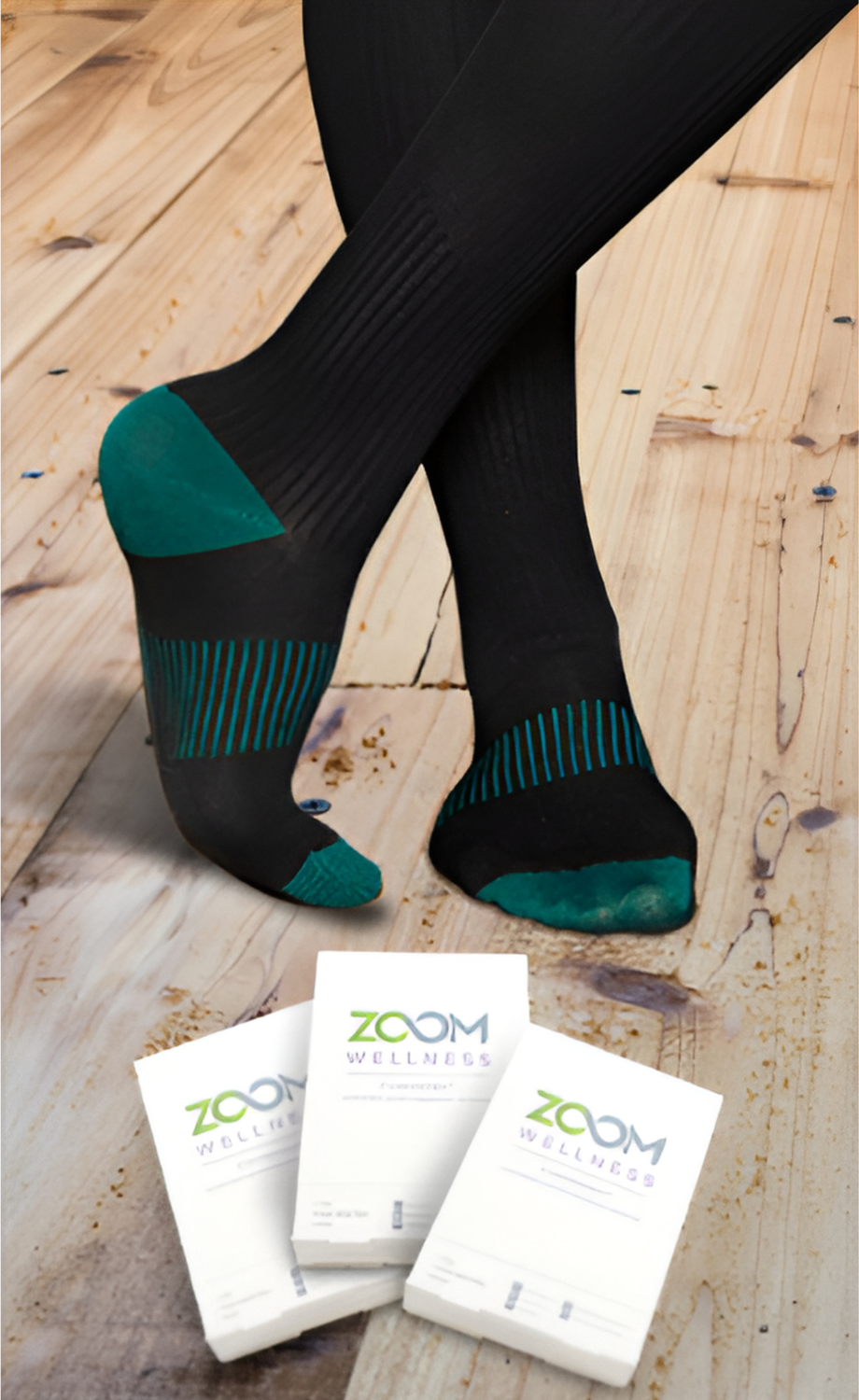Men & Women Compression Socks for Neuropathy

3 x Compression Socks for Neuropathy – (S/M/L/XL)

Choose your size:
Are you seeking relief from the discomfort of neuropathy? If so, you’re not alone. Neuropathy, a condition characterized by nerve damage often resulting in tingling, numbness, and pain, can significantly impact your daily life. Fortunately, there’s hope on the horizon in the form of compression socks. In this guide, we’ll dive into how compression socks can be a game-changer for managing neuropathy symptoms. Join me as we explore the intersection of neuropathy and compression socks, unlocking the key to enhanced comfort and relief.
Understanding Neuropathy
Neuropathy, a complex and often debilitating condition, arises from nerve damage that disrupts the transmission of signals between the brain and various parts of the body. This disruption can lead to a wide array of symptoms, with tingling, numbness, and pain being the most common. Neuropathy commonly affects the extremities, particularly the feet and legs, although it can also manifest in other areas of the body.
The causes of neuropathy are diverse and multifaceted. Diabetes stands as one of the most prevalent causes, with prolonged high blood sugar levels damaging nerve fibers over time. Autoimmune diseases, such as lupus or rheumatoid arthritis, can trigger neuropathy through the immune system’s attack on nerve tissues. Infections, such as Lyme disease or shingles, can also lead to nerve damage. Additionally, injuries, exposure to toxins, and certain medications are known to contribute to neuropathy development.
The impact of neuropathy on daily life can be profound, extending beyond physical discomfort to affect emotional well-being and overall quality of life. Individuals with neuropathy may experience difficulty walking or performing routine tasks, leading to decreased mobility and independence. Furthermore, the constant presence of symptoms like pain and numbness can disrupt sleep patterns and impair concentration, exacerbating feelings of frustration and fatigue.
Exploring Compression Socks
Enter compression socks—a promising solution for neuropathy management. These specialized garments gently apply pressure to boost circulation, relieving symptoms like numbness and discomfort. However, it’s essential to acknowledge potential drawbacks, such as discomfort for some wearers or allergic reactions to certain materials.
Choosing the Right Compression Socks
Explore different compression levels, materials, and features tailored to address neuropathy symptoms effectively. Proper sizing and fit are crucial for optimal results. Consider the following factors when choosing compression socks for neuropathy relief:
- Compression Level: Compression socks are available in different compression levels, typically ranging from mild (15-20 mmHg) to firm (30-40 mmHg). Higher levels of compression may be more suitable for individuals with severe neuropathy symptoms.
- Material: Look for compression socks made from breathable and moisture-wicking materials, such as nylon or spandex, to ensure comfort and durability.
- Features: Consider additional features such as seamless toe closures, cushioned soles, and non-binding tops to minimize irritation and enhance comfort, especially for individuals with sensitive skin or neuropathic pain.
Usage Instructions
To maximize the benefits of compression socks, it’s important to wear them consistently and correctly. Start by putting on clean, dry socks in the morning, and avoid wearing them overnight unless instructed by a healthcare professional. Remember to remove them before bedtime and wash them according to the manufacturer’s instructions to maintain their effectiveness.
Potential Side Effects
While compression socks are generally safe, some individuals may experience side effects such as skin irritation or discomfort. If you experience any adverse reactions while wearing compression socks, such as increased pain or swelling, discontinue use and consult a healthcare provider for further guidance.
Types of Compression
There are different types of compression socks available, each offering varying levels of pressure and support. Graduated compression socks, for example, provide more pressure at the ankle and gradually decrease towards the calf, promoting optimal blood flow. Diabetic compression socks are designed with extra cushioning and moisture-wicking properties to minimize the risk of skin irritation and infection.
- Graduated Compression Socks: These socks apply the highest level of pressure at the ankle and gradually decrease pressure towards the calf. This design promotes optimal blood flow and reduces swelling, making them suitable for managing neuropathy symptoms.
- Diabetic Compression Socks: Specifically designed for individuals with diabetes, diabetic compression socks offer extra cushioning and moisture-wicking properties. They provide gentle compression to improve circulation while minimizing the risk of skin irritation and infection, making them ideal for neuropathy sufferers with sensitive skin.
- Uniform Compression Socks: Unlike graduated compression socks, uniform compression socks apply consistent pressure throughout the length of the sock. While they may not offer the same targeted compression as graduated socks, they still provide benefits for improving circulation and relieving neuropathic symptoms.
- Custom Compression Socks: For individuals with specific needs or preferences, custom compression socks can be tailored to fit their unique measurements and address particular neuropathy symptoms. These socks offer a personalized solution for those seeking maximum comfort and effectiveness in managing their condition.
Alternative Treatments
While compression socks can be an effective treatment option for neuropathy, they may not be suitable for everyone. It’s essential to explore alternative therapies or complementary approaches, such as physical therapy, acupuncture, or medication, to manage neuropathic symptoms effectively. Discussing these options with a healthcare provider can help develop a personalized treatment plan tailored to your specific needs.
- Physical Therapy: Physical therapy exercises and techniques can help improve strength, flexibility, and balance, reducing neuropathic pain and enhancing mobility. Therapists may employ modalities such as massage, stretching, and low-impact exercises tailored to the individual’s needs.
- Medications: Various medications, including over-the-counter pain relievers, prescription drugs, and topical creams, may be prescribed to manage neuropathic pain and discomfort. These medications target different aspects of neuropathy, such as pain perception, nerve function, or inflammation.
- Acupuncture: Acupuncture involves the insertion of thin needles into specific points on the body to stimulate nerve function and promote healing. Some studies suggest that acupuncture may help alleviate neuropathic pain and improve nerve function, although further research is needed to confirm its efficacy.
- Nutritional Supplements: Certain vitamins and supplements, such as vitamin B12, alpha-lipoic acid, and omega-3 fatty acids, may offer benefits for neuropathy management. These supplements support nerve health, reduce inflammation, and improve nerve function, potentially alleviating symptoms and promoting nerve regeneration.
- Transcutaneous Electrical Nerve Stimulation (TENS): TENS therapy involves the use of a small, battery-operated device that delivers low-voltage electrical impulses to the affected area through electrodes placed on the skin. These electrical impulses help block pain signals and stimulate nerve function, providing temporary relief from neuropathic pain and discomfort.
- Lifestyle Modifications: Making lifestyle changes, such as maintaining a healthy diet, engaging in regular exercise, quitting smoking, and managing stress, can have a significant impact on neuropathy symptoms. These lifestyle modifications can improve overall health, reduce inflammation, and promote nerve regeneration, ultimately contributing to better symptom management and quality of life.
Realizing Benefits
Uncover firsthand accounts and testimonials showcasing the transformative effects of compression socks. Improved circulation, reduced pain, and enhanced overall well-being await those who embrace this solution.
- Enhanced Comfort
- Improved Mobility
- Increased Independence
- Better Sleep Quality
- Enhanced Well-Being
- Confidence and Empowerment
Conclusion
In conclusion, compression socks offer a beacon of hope for neuropathy sufferers seeking relief. By understanding the intricacies of neuropathy management and selecting the right compression socks, individuals can embark on a journey towards enhanced comfort and improved quality of life. Experience the synergy of neuropathy management with compression socks and embrace a brighter, more comfortable future.



Leave a Reply